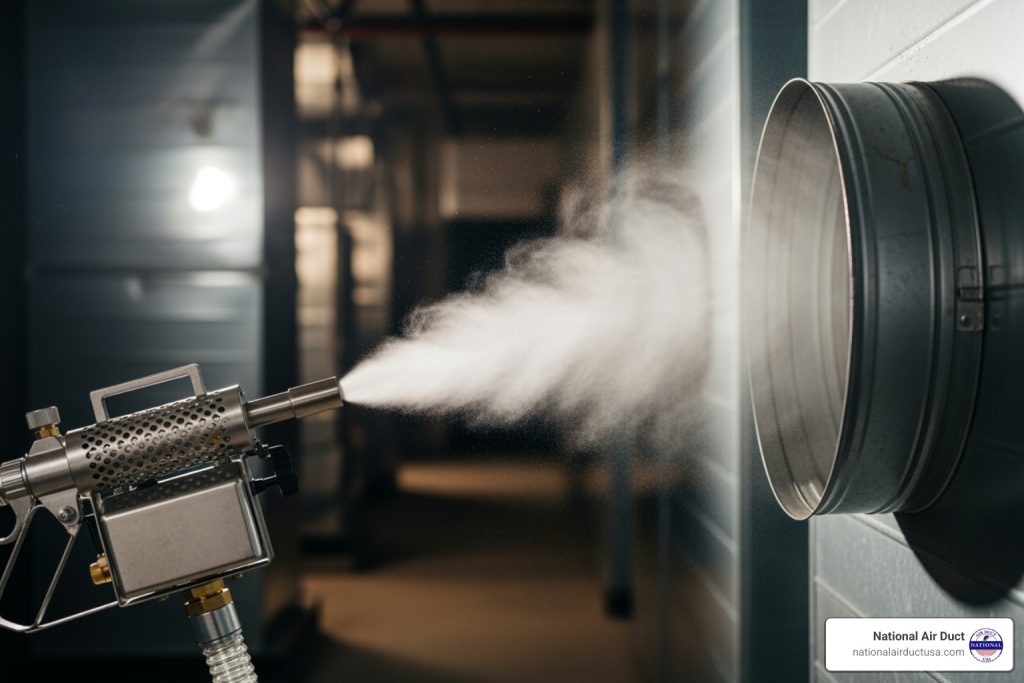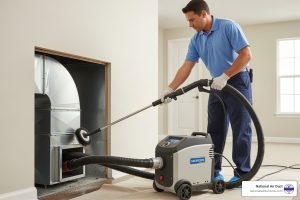Why Air Duct Sanitizing Foggers Are Essential for Clean Indoor Air
An air duct sanitizing fogger is a specialized device that uses an ultra-fine mist to deliver EPA-approved disinfectants throughout your HVAC system. This process kills bacteria, mold, and viruses while eliminating odors that traditional cleaning can’t reach.
Your home’s air ducts can harbor invisible threats that affect your family’s health. As NADCA President Mark Zarzeczny notes, many homeowners don’t realize that “air vents are one of the main distributors of germs through an entire building.“
The hidden problem is circulation. Every time your HVAC system runs, it can spread dust, allergens, and mold spores. While standard duct cleaning removes visible debris, sanitizing with a fogger takes it a step further by killing microscopic contaminants.
Professional-grade air duct sanitizing foggers create particles as small as 5-80 microns, fine enough to coat every surface in your ductwork. However, proper application is critical. Foggers must be used with the right chemicals, following strict safety protocols, and as part of a comprehensive cleaning process that first removes the source of contaminants.

Quick air duct sanitizing fogger terms:
What is an Air Duct Sanitizing Fogger and How Does It Work?
An air duct sanitizing fogger is a professional tool that transforms liquid sanitizing solutions into a fine, disinfecting fog. Through a process called atomization, it breaks down EPA-registered antimicrobial solutions into microscopic particles, typically ranging from 5 to 80 microns—finer than a human hair.
Professionals use ULV cold fogging (Ultra Low Volume) technology, which creates a fine, non-wetting mist that hangs in the air. This precision is crucial for treating ductwork effectively without causing moisture damage.

Once the fog is introduced into your HVAC system circulation, usually at the return air side, your system’s blower fan distributes the mist throughout the entire network. This ensures the sanitizing agent reaches every nook, cranny, and ductwork surface that manual cleaning cannot.
As these particles settle, the EPA-registered antimicrobial agents get to work killing contaminants on contact. This includes mold spores, bacteria colonies, and viruses. The process also excels at odor elimination, neutralizing the molecules that cause musty, pet, or smoke smells at their source, rather than just masking them.
The beauty of this system is its thoroughness. Unlike surface cleaning, fogging ensures that the sanitizing solution makes contact with virtually every surface inside your ducts for a comprehensive treatment.
For a comprehensive look at the entire disinfection process, check out our detailed guide on How to Disinfect Air Ducts.
Key Benefits of Sanitizing Your Air Ducts with a Fogger
Sanitizing your home’s ductwork with an air duct sanitizing fogger offers significant benefits for your home’s air quality and your family’s comfort. While the improvements happen inside your ducts, the results are felt throughout your home.

Improved Indoor Air Quality
Your HVAC system can circulate dust mite debris, pollen, pet dander, and other allergens throughout your home. An air duct sanitizing fogger gives your duct system a deep cleanse, neutralizing these microscopic irritants. This creates a healthier breathing environment and can provide significant asthma relief and fewer allergy symptoms for sensitive family members.
Mold and Bacteria Elimination
The dark, humid environment inside ducts can be a breeding ground for mold spores and bacterial colonies, especially in high humidity environments. The antimicrobial agents in professional fogging solutions actively combat mold growth and neutralize dangerous spores before they can spread. This eliminates the source of musty odors and protects your home from microbial threats. For comprehensive protection, this works hand-in-hand with maintaining a Clean Ventilation System.
Odor Removal
Persistent musty odors, lingering pet smells, smoke residue, or stubborn cooking aromas often get trapped in the surfaces of your ductwork. An air duct sanitizing fogger tackles this by rendering odor molecules inert at their source. The fine mist penetrates every surface, neutralizing the cause of the smell for a genuinely fresh and clean home.
Improved HVAC Efficiency
A sanitized duct system can also help your HVAC work more efficiently. When ducts are free from the buildup of microbial growth, air flows more freely. This better airflow leads to reduced strain on your system. While not a primary benefit, this can contribute to smoother operation and potential energy savings over time. Professional Blower Cleaning works alongside sanitizing to maximize these efficiency benefits.
Choosing the Right Air Duct Sanitizing Fogger and Solution
Picking the right equipment and chemicals for air duct sanitization is critical for both effectiveness and safety. It involves understanding fogger types, chemical safety, and EPA regulations for substances introduced into your home’s breathing system.
Types of Foggers Used by Professionals
Professionals use ULV (Ultra Low Volume) cold foggers. Unlike thermal foggers that use heat, these specialized machines create a fine, cool mist that penetrates deep into ductwork without degrading sensitive chemicals or creating hazards. Professional-grade equipment is built for durability and has precision controls that are essential for proper HVAC sanitization, making this a job best left to trained technicians.
What to Look for in an Air Duct Sanitizing Fogger
A quality air duct sanitizing fogger has several key features. Adjustable flow rate allows for precise control over the amount of solution dispensed, preventing over-wetting. The ability to produce a specific particle size (typically 5-80 microns) ensures the mist is fine enough to travel throughout the duct system. Other important features include adequate tank capacity for treating an entire home efficiently, a long, flexible hose for accessing all parts of the system, and durability with chemically-resistant seals.
Understanding Sanitizing Solutions: What’s Safe and Effective?
The solution used in a fogger must be EPA-registered and specifically labeled for HVAC system use. Using an unapproved product is not only potentially unsafe but also violates federal law under the Summary of the Federal Insecticide, Fungicide and Rodenticide Act (FIFRA).
- Botanical-based ingredients like thymol (from thyme) are effective antimicrobial, antifungal, and antiviral agents. They are often considered safer for occupied spaces, though proper ventilation is still essential.
- Chemical disinfectants like quaternary ammonium compounds (QACs) provide powerful action against specific microbial threats but require strict adherence to safety protocols.
Safety is always the top priority. The product label dictates dilution, application methods, dwell times, and required personal protective equipment (PPE). As we explain in our guide Can You Spray Disinfectant in Air Ducts?, there’s a world of difference between doing it right and creating a bigger problem.
Why Professional Air Duct Sanitizing is the Best Choice
While DIY fogging might seem tempting, there’s a world of difference between having the equipment and knowing how to use it safely and effectively. The risks of improper application far outweigh any potential savings and can even make your air quality worse.
The Importance of Professional Service
Air duct sanitization requires specialized knowledge and training. As NADCA-certified technicians, we follow the industry’s highest standards for safety and effectiveness. A critical part of this is that source removal comes first. The NADCA’s official stance is that physical cleaning to remove contaminants is the primary step. An air duct sanitizing fogger is a supplement to a thorough cleaning, not a replacement for it. Simply spraying chemicals into dirty ducts is ineffective.
Our professional-grade equipment also makes a real difference. We use ULV cold foggers with precise controls to ensure optimal coverage without over-wetting your ducts. Furthermore, we adhere to strict safety compliance, handling EPA-registered chemicals according to FIFRA regulations, using proper PPE, and ensuring correct ventilation.
We guarantee comprehensive coverage, ensuring the sanitizing mist reaches every necessary surface. For a thorough approach that puts your family’s health first, explore our Residential Air Duct Cleaning services, which include professional sanitization when needed.
Table: Comparing Non-Professional vs. Professional Duct Sanitizing
| Feature | Non-Professional (DIY) | Professional Service (National Air Duct USA) |
|---|---|---|
| Cost | Lower upfront cost (product + basic fogger) | Higher upfront cost (service fee) |
| Effectiveness | Often superficial; may not reach all areas; masks odors | Comprehensive; deep penetration; eliminates odors at source; backed by cleaning |
| Safety | Higher risk of improper chemical handling/exposure; inadequate ventilation | Strict adherence to safety protocols, PPE, proper ventilation; EPA compliance |
| Time | Quick application; potentially ineffective | Thorough process including inspection, cleaning, and precise sanitization |
| Equipment | Consumer-grade foggers; limited features | Professional-grade ULV cold foggers; adjustable flow, specific particle size |
| Expertise | Limited knowledge of HVAC systems/chemical interactions | NADCA-certified technicians; deep understanding of duct systems and chemical properties |
| Result | Temporary relief; potential for recontamination | Long-lasting improvement in air quality; addresses root causes |
The bottom line is that professional service addresses the root causes of poor indoor air quality with a comprehensive approach that prioritizes your family’s health and safety.
How Professionals Use an Air Duct Sanitizing Fogger: A Step-by-Step Guide
When our NADCA-certified technicians perform a sanitization service, they follow a careful, methodical process to ensure safety and effectiveness. Every step is crucial for a successful outcome.

Step 1: Preparation is Key
Before fogging begins, we prepare the area to create a controlled environment. This involves turning off the HVAC system, and our technicians put on full PPE (respirators, gloves, eye protection). We then cover all supply and return vents, often with paper that also serves as a visual indicator that the fog has reached the vent. Finally, we protect floors and furniture near the registers with plastic sheeting.
Step 2: The Fogging Process
We fill our professional-grade fogger with an EPA-registered sanitizing solution labeled for HVAC use. The process starts at the return air side, where we fog for several minutes to let the mist concentrate. We then access the supply plenum to treat the heart of the system. With the blower fan on, we fog the main ductwork, using approximately 1 gallon of solution per 2,000 square feet. We monitor the vent coverings to confirm the fog has penetrated the entire system, treating individual registers directly if needed.
Step 3: Post-Fogging Procedure
After application, the job isn’t finished. We respect the product’s specified dwell time, allowing the sanitizer to remain on surfaces to eliminate microorganisms effectively. Once the dwell time is complete, we ensure thorough ventilation of the home by opening windows and doors. Finally, we turn on the HVAC blower to air-dry all interior duct surfaces, preventing moisture buildup. We handle the safe disposal of any remaining solution and used PPE according to environmental guidelines.
This comprehensive approach ensures your treatment delivers real, lasting results. For more insights, explore our guide on Disinfecting Air Ducts.
Frequently Asked Questions about Air Duct Fogging
Homeowners often have thoughtful questions about when and how air duct sanitizing makes sense for their families. Here are clear, honest answers to the most common inquiries.
When is air duct sanitizing recommended?
Sanitizing with an air duct sanitizing fogger is not a routine maintenance task but a targeted solution for specific problems. It is most effective when performed:
- After professional cleaning: Once debris is removed, the fog can treat clean surfaces to eliminate microscopic threats.
- Following water damage or flooding: To combat the mold and bacteria that thrive in damp environments.
- As part of mold remediation: To neutralize spores that cleaning alone might miss.
- To eliminate persistent odors: For musty, pet, or smoke smells that signal deeper issues.
- For severe allergies or respiratory issues: To provide an extra layer of protection against airborne irritants.
- After a major renovation: To clear out excessive dust and potential contaminants, as discussed in our article Should You Clean Your Air Ducts Post Renovation?.
How often should I sanitize my air ducts?
There is no set schedule for sanitizing. Unlike duct cleaning (typically recommended every 3-5 years), sanitizing is a targeted treatment performed on an as-needed basis. If your ducts are clean and your system is well-maintained, you likely won’t need sanitizing again unless a specific issue like water damage or mold growth occurs. It’s about responding to a problem, not routine prevention.
Is the fog from an air duct sanitizing fogger safe for pets and children?
Safety is our top priority and depends entirely on the product used and strict adherence to protocols. Some botanical solutions, like those with Thymol, are EPA-approved and often considered safe enough for occupants to remain home during treatment, with proper ventilation. However, other disinfectants require stricter measures. The product label is the law and dictates whether occupants, including pets, must leave the home and for how long.
Proper ventilation is always essential. We are always transparent about the products we use, their safety profiles, and any necessary precautions. Your family’s safety is non-negotiable.
Conclusion: The Final Word on Cleaner, Healthier Air
An air duct sanitizing fogger is a powerful tool for achieving a cleaner, healthier home environment. It offers a proven method to eliminate the microscopic mold spores, bacteria, and viruses that traditional cleaning can’t reach. However, its effectiveness and safety depend entirely on proper application.
Sanitizing is not a standalone solution. It must be performed as part of a comprehensive approach that begins with thorough physical cleaning to remove the source of contaminants. This is why professional service is not just a recommendation, but a necessity for a safe and successful outcome. Using the correct EPA-registered chemicals, adhering to safety protocols, and understanding the complexities of an HVAC system are critical.
At National Air Duct USA, our NADCA-certified technicians are committed to this professional standard. We don’t just treat symptoms; we address the root causes of poor air quality to provide lasting results. The investment in professional air duct cleaning and sanitization pays dividends in improved health, better HVAC efficiency, and genuine peace of mind.
For a comprehensive approach to improving your home’s air quality, explore our professional disinfecting air duct services. Because when it comes to the air you breathe, you deserve the very best.



